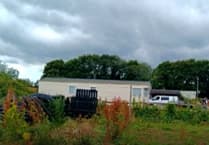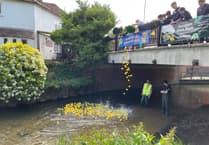HOLLYCOMBE Steam Collection has been entertaining the young and not so young for more than 30 years - and it's all thanks to the lifelong passion of a retired naval commander from Liphook.
Commander John Baldock (85) has overseen the growth of his open air museum from a single engine in 1952 to the largest collection of unique steam-powered attractions in the country.
Visitors come in their thousands every year to see steam engines, ride the railway across the Surrey Weald and enjoy all the fun of an all-steam powered fairground.
His love for the bygone age of steam comes from a passion "to demonstrate how magnificent engineering was in the days of steam and show that the young can strive to that level of achievement in their own lives".
Although the collection began when Cmdr Baldock purchased his very first steam engine, "Sunset", nearly 50 years ago, his interest in the subject stems from a much earlier age.
Growing up on his parents' Liphook farm, he saw hop kilns run by traction engines, and his uncle had a small steam railway of his own.
He told The Herald: "I found a letter the other day from when I was six or seven, asking Father Christmas for a steam engine!
"As for why steam interests me specifically, I can't say. It's innate, you may as well ask why someone likes riding or decorating."
"I can tell you, though, who it was exactly that gave me the idea to open my collection as a museum. His name was Mr White of Midhurst, a local press photographer who one day in 1970 said to me: 'Why don't you open these things for the public to view and make some money?'"
However, in reality this proved problematic. Cmdr Baldock said: "We had tremendous trouble with the no-longer existent Midhurst District Council, who thought we'd make a terrible noise and be like a Butlin's fun fair."
Money was also an issue: "I ran it myself for the first 17 years, but ended up having to pay for everything, because the money we got back from visitors didn't cover the enormous running costs, so I had to subsidise it.
"In fact I was going to pack up in 1985, but then Chris Hooker - now the manager - suggested people would be willing to work as volunteers. I didn't think it would work, so I tried it for a year's trial and it was a success. Since then it has supported itself."
Indeed, the volunteers are vital to the continued smooth running of the museum.
Cmdr Baldock said: "We couldn't do it without them. On average it takes 35 people to run all of the attractions.
"We have people come down from Devon and Worcestershire and all kinds of places. They stay on the land in their caravans, so they can be here for the weekend instead of having to go back and forth all the time.
"Each volunteer becomes a member of HSWGS and they then encourage other people to join.
" We have had three generations come through - fathers will come with their children here and then they stay on to help. It' s the same with visitors, you see the same faces."
Chris Hooker, who organises the volunteers, added: "We do advertise locally, but we always need more people, especially from the immediate area."
The crucial turning point for the collection came in 1998, when it was given charitable status as the Hollycombe Steam and Woodland Gardens Society.
Cmdr Baldock said: "We were finally accepted as a charity because we only have volunteers and are a non-profit organisation, although it is quite difficult to get registered if you aren't helping people directly."
"What really put the seal on our respectability, though, was the three quarters of a million pound grant from the Heritage Lottery that followed."
It solved concerns that the historic attraction may spoil the local countryside, an area of outstanding natural beauty.
Every engine except one is from the UK and almost all are unique.
The collection dates back to Victorian to early Edwardian times, the earliest period that working steam-driven equipment can still be acquired.
However Cmdr Baldock's intention was not only to entertain, but also to educate new generations about the golden age of British manufacturing, the Industrial Revolution.
"At the time of the Industrial Revolution we were the hub of the world. It made us rich and prosperous at the end of the 18th century.
Sadly we no longer seem to have the ability to do this by ourselves. We threw it all away, with bad management, strikes and, frankly, bad design."
Acquiring these working historical monuments is an expensive business, though.
Said Cmdr Baldock: "Through hearsay and word of mouth people would hear that I was interested, and then get in touch. I also advertise, and used to go to the World's Fair.
"The cost of buying them has gone up enormously. The first I bought, Sunset, was £25, which was scrap value. Now they're collectables.
"The most expensive Sherman engine we have is worth a quarter of A million pounds."
Asked which part of his collection is his favourite, Cmdr Baldock said: "I would have to say Sunset, my first engine. I've driven hundreds of miles on her over the years, and she still runs today.
"I'm also very keen on 'Dawn of the Century', a grand electric bioscope organ. It is equivalent to a full military band - 650 pipes, trombones, piccolos, baritones, saxophones, etc.
"It plays music from hand-punched cardboard sheets that are registered by pins that each correspond to the different instruments.
My favourite piece of music is The Merengue Waltz , named after the inventor who really knew how to get the most out of it."
Like many of Hollycombe's steam attractions, the bioscope was languishing unused, packed up in boxes, and so the commander was pleased to be able to restore it to its former working glory.
One of his proudest moments came earlier this year when Cmdr Baldock was honoured to be named an MBE in the Queen's New Year Honours for services to Hollycombe.
Aside from his involvement in the museum, Cmdr Baldock has had a hugely varied career.
He served in the torpedo branch of the Navy immediately before and after the war,
He is also the director of several companies, including a beef farm and a small building products company.
A lifelong Conservative, he was elected MP for Market Harborough in Leicester in the 1950s, despite not actually living in the constituency.
He said: "Very kindly, people let me stay there in their homes - it's a good way of getting to know people."
Married in 1949, John and his wife Pauline celebrated their golden wedding anniversary two years ago.
Mrs Baldock is not directly involved with the museum, instead working with other charities such as the NSPCC, and also the church.
They have two sons; Christopher and David. It is David that shares his father's interest in steam and the commander hopes that eventually he will follow in his footsteps and help run the collection.
More immediate plans for the future include using a recently applied-for grant to house the engines in buildings, and to extend the station facilities.
And more than 30 years after he first started the collection, Cmdr Baldock is still making sure the crowds keep on coming, with yet another new attraction planned.
Making its first appearance at Hollycombe next year is a 2,000 horse power engine from a paddle steamer. The Caledonia was launched in 1934 but was requisitioned by the Navy during world war two and renamed HMS Goatfell.
Withdrawn from service in 1969, two years later it was bought by the brewers Bass Charrington, Ltd, and turned into a floating restaurant and moored on the River Thames. However several years ago the vessel caught fire, and although the shell was beyond repair, the main engine was salvaged, and bought by Cmdr Baldock.
Hollycombe Steam Museum runs from Easter to October, Sundays and bank holidays, and every day throughout August.
Forthcoming summertime events include a night time fairground on Saturday August 25, and a special bank holiday railway weekend on August 25 - 27.
For more information call 01428 724 900, or visit http://www.hollycombe.co.uk">www.hollycombe.co.uk


